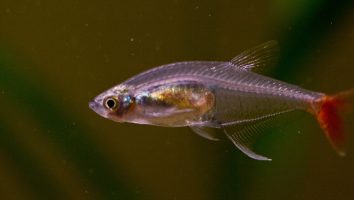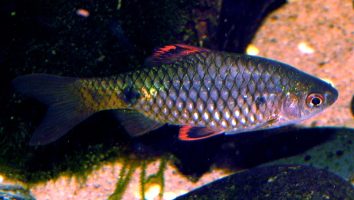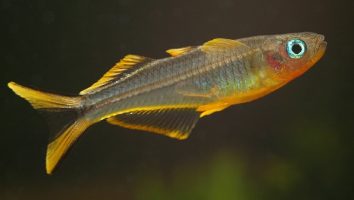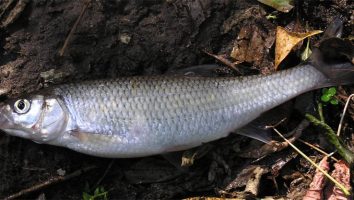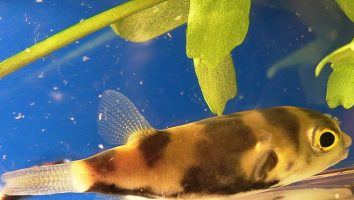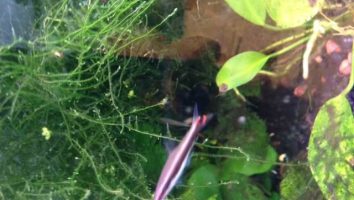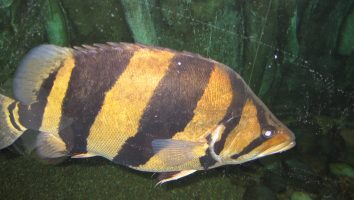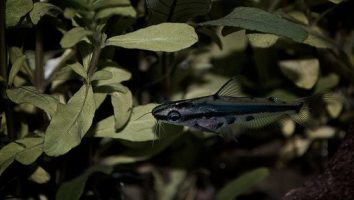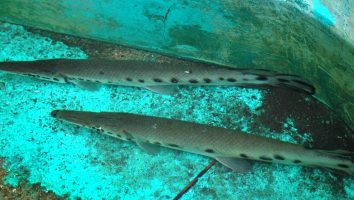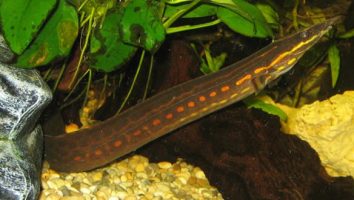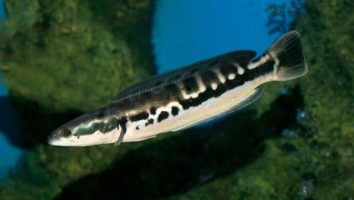The red devil cichlid is a beautiful and popular freshwater fish that is easy to care for.
This species is native to Central America and is known for its aggression. In the wild, they are known to eat other fish, crustaceans, and even reptiles!
If you’re thinking about getting a red devil cichlid, you need to be prepared for their aggressive behavior. But don’t worry, we’ll teach you everything you need to know about red devil cichlid care in this guide.
Table of contents
Species overview
The Red Devil Cichlid (Amphilophus labiatus) is a freshwater fish that’s native to Central America. It’s found in rivers and lakes in countries like Nicaragua, Costa Rica, and Panama.
The red devil cichlid is a large fish, reaching up to 18 inches in length in some cases. They are aggressive and territorial, which means they need a lot of space to themselves.
This fish is not for the beginner aquarist. They require a lot of care and attention, and their aggressive nature means they need to be kept with other fish that can hold their own.
Despite all of this, the red devil cichlid is a beautiful fish that can make a great addition to the right aquarium.
Appearance
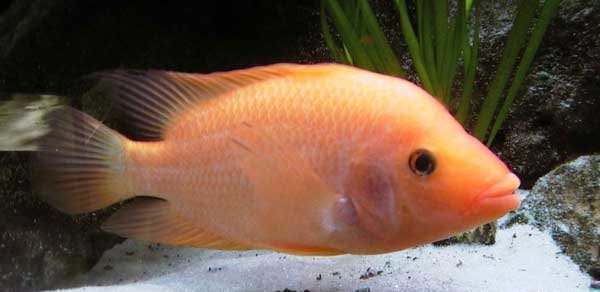
The first thing you’ll notice about this fish is their large size. They can grow up to be a foot long!
The body of the red devil cichlid is long and thick. They have a very muscular build that tapers down from their midsection to their caudal peduncle.
This fish has a very large head with a protruding lower jaw. The mouth of the red devil cichlid is full of sharp teeth that they use to tear apart their food.
The fins on this fish are also quite large. The dorsal fin starts about halfway back on the body and extends all the way to the tail.
The anal fin is similar in size and shape to the dorsal fin. It starts a little bit closer to the head of the fish though.
The pectoral fins of the red devil cichlid are large and triangular. They start right behind the gill plate and extend to about the middle of the body.
The caudal fin is forked and slightly rounded at the tips.
This fish is mostly a reddish-brown color. They have vertical bars that run down their body (these are more visible in juveniles).
There is also a black spot on the base of their caudal fin. This spot is surrounded by a bright red or orange ring.
Lifespan
Red devil cichlids typically have a lifespan of 10 to 12 years. However, there are many variables that can impact their lifespan, such as water quality, diet, and stress levels.
With proper care, though, it is not uncommon for red devil cichlids to live up to 15 years or even longer!
Size
The red devil cichlid is a large fish, with some specimens reaching lengths of up to 18 inches. However, the average size of this fish is more like 12 to 14 inches.
You need to be aware of the size of this aquarium fish when planning their tank setup. Not only does this mean you’ll need more space for them, but it affects everything from feeding to tank mates.
Tank
Tank Size
The recommended tank size for red devil cichlids is at least 50 gallons. If you’re keeping more than one fish, you should add another 50 gallons for each fish.
Red devil cichlids are large and active fish that need a lot of space to swim and explore. They are also known to be aggressive and territorial, so it’s important to give them enough space to claim their own territory in the tank.
Water Parameters
The red devil cichlid is a freshwater fish that is native to Central America. In the wild, they can be found in rivers and streams with a rocky substrate.
The water parameters you need to maintain for red devil cichlids are pretty typical for most freshwater fish. They prefer a water temperature in the mid-70s and a neutral to slightly alkaline pH.
The most important thing to remember with red devil cichlids is that they are very aggressive. They are known to be one of the most aggressive cichlid species, so be sure to provide plenty of hiding places and give them plenty of space.
- Water Temperature: 72-82 degrees Fahrenheit
- pH Levels: 6.8-7.6
- Water hardness: 8-20 dGH
- Alkalinity Levels: 2-12 dKH
What To Put In Their Tank
There are two schools of thought when it comes to setting up an aquarium for a Red Devil Cichlid.
The first is to go with a very simple setup. This means a substrate of gravel or sand with just a few rocks and driftwood for decoration.
The second option is to go all out and create an underwater jungle. This is the setup we prefer since it’s much more visually appealing and provides the fish with plenty of places to hide.
If you decide to go with the latter, then you’ll need to be careful about the plants you choose. Red Devil Cichlids are known to uproot plants, so you’ll need something that can handle that (like Java Fern or Anubias).
You’ll also want to make sure the plants are securely anchored since these fish like to dig around in the substrate.
Rocks and driftwood are a must in either case. These provide hiding places for your fish and help break up the line of sight in the aquarium.
Aquarium size is also something to consider. Red Devil Cichlids can grow quite large, so you’ll need a tank that can accommodate them. We recommend a minimum of 75 gallons for a single fish.
Common Diseases
Red devil cichlids are actually pretty hardy fish. They’re not immune to disease, but they don’t seem to fall ill as often as some other freshwater species.
The most common disease you’ll see with these fish is ich. This is a pretty common freshwater disease that usually affects fish that are kept in subpar water conditions.
The most obvious symptom of ich is the presence of white spots on the body, fins, and gills of your fish. If you notice this, it’s important to take action immediately.
If you don’t treat ich, it can quickly become fatal for your fish. While ich is definitely the most common disease you’ll see with red devils, there are a few others worth mentioning.
Another one to look out for is hole-in-the-head disease. This disease is pretty easy to spot, as it will cause literal holes to form in the head of your fish.
This is caused by poor water quality and the presence of activated carbon in the tank. If you notice this, the best thing to do is to improve the water quality and remove the activated carbon.
While these are the most common diseases you’ll see with red devils, there are plenty of others that can affect them. The best way to keep your fish healthy is to maintain a clean and stable tank.
Behavior & Temperament
The red devil cichlid is aptly named. It’s one of the most aggressive freshwater fish in the world. In the wild, these fish are known to kill and eat anything that they can fit in their mouths. This includes other fish, crustaceans, amphibians, and even small mammals!
While they can be kept in aquariums, it’s important to know that they will likely kill any fish that they see as competition. This includes other cichlids, as well as any fish that is small enough to fit in their mouths. If you’re not careful, you could come home to find that your red devil cichlid has eaten all of your other fish!
In addition to being aggressive, red devil cichlids are also very territorial. They will claim a small area of the tank as their own and defend it fiercely. If another fish comes too close, the red devil cichlid will chase it away or even attack it.
For these reasons, it’s important to only keep one red devil cichlid per tank. They can be kept with other fish, but only if the tank is large enough for everyone to have their own space. Otherwise, the red devil cichlid will make everyone’s life a living hell!
Tank Mates
The red devil cichlid is a large and in charge freshwater fish. It’s not the type of species you want to add to a community tank.
Instead, these fish are best kept alone or with other large and aggressive cichlids.
Matched in size and aggression, the following species make good tank mates for red devil cichlids:
- Green Terror Cichlid
- Jack Dempsey Cichlid
- Firemouth Cichlid
- Convict Cichlid
- Oscar Cichlid
- Plecostomus (large enough to not be eaten)
Breeding
Red devil cichlids are one of the easier species to breed in captivity. That being said, they’re still cichlids. They can be aggressive, and you need to take some precautions to make sure that everything goes according to plan.
The first step is to set up a breeding tank. It should be at least 50 gallons, and you need to make sure that there are plenty of hiding places. Caves, driftwood, and plants all work well.
Then, you need to sex your fish. This can be tricky, as males and females look very similar. The easiest way to tell them apart is by their behavior. Males are much more aggressive, and they’ll establish a hierarchy within the tank.
Once you’ve got your pair, it’s time to trigger spawning. The easiest way to do that is by doing a large water change. This will simulate the rainy season and trigger the fish’s breeding instincts.
After the water change, you should see the female start to lay eggs. She’ll usually lay them on a flat surface like a rock or a piece of driftwood. The male will then fertilize them.
Once the eggs are laid, the male will guard them diligently. He won’t let anything near them, not even the female.
The eggs will hatch in about three days. At that point, you can remove the adults and let the fry fend for themselves. They’ll eat anything that they can fit in their mouths, so you don’t need to worry about feeding them.
Just make sure that you keep an eye on the water quality. The fry produce a lot of waste, and the ammonia can quickly build up. Do regular water changes to avoid any problems.
Conclusion
The red devil cichlid is a beautiful fish that can add a lot of personality to your tank. They’re relatively easy to care for but do require some special attention when it comes to feeding and tank mates.
Overall, we think they’re a great fish for anyone who wants to add a little bit of spice to their aquarium. Just be sure to do your research and be prepared for their sometimes aggressive behavior.

